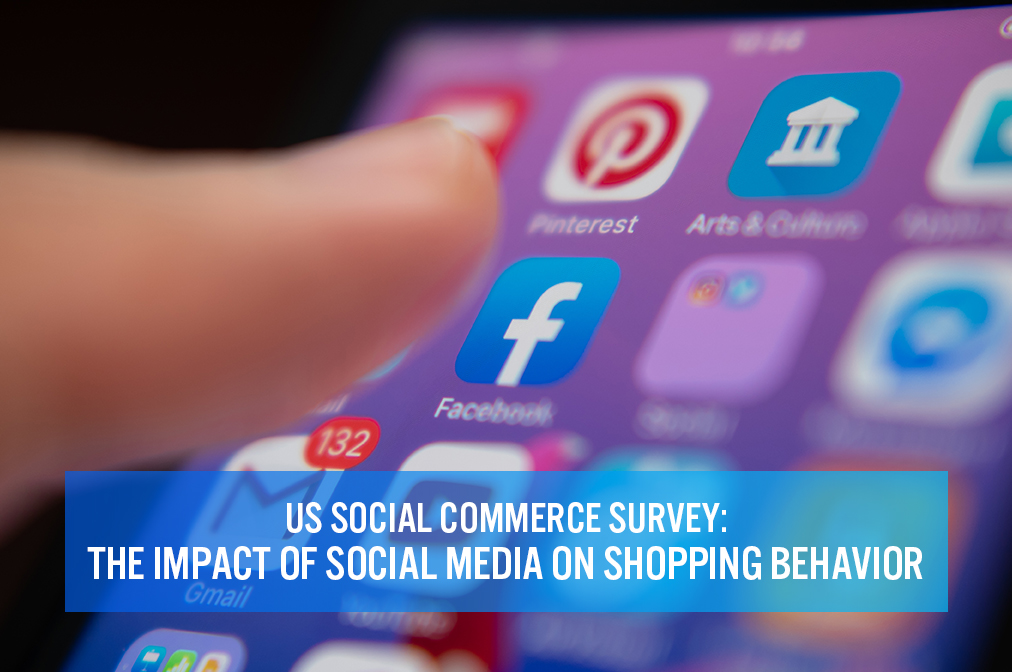
Nitheesh NH
Introduction
In the past decade, social media has transformed from a platform that connects people to a marketplace where consumers can share their experiences and make purchases. Influencers on various platforms serve as key opinion leaders (KOLs), impacting user preferences and purchasing behaviors. Social media sites are therefore looking to capitalize on consumer trends by adding e-commerce features that allow consumers to shop directly on their platforms. Social media and e-commerce together form a new social commerce channel. In the near term, the store closures and consumer isolation associated with the coronavirus outbreak are likely to amplify social media’s role as a sales channel. This is the second report of a four-part series in which we explore the results of a Coresight Research survey of US consumers on their use of social media for shopping. This series will include three thematic reports and an overall summary of our findings. We surveyed 1,509 US Internet users aged 18 and above in November 2019. We asked respondents about a number of topics relating to their use of social media for shopping, including the following:- How often they research and discover or purchase products through social media
- What products they have recently bought on social media
- How often social media shoppers do not convert research to purchasing
- How often influencers and celebrities affect their shopping
Insights from Our Survey
Facebook is the most widely used social media platform for shopping, but Instagram is the most popular among respondents aged 18–24. Pinterest is popular among women of all ages, with 37.3% of female social media shoppers using this platform. Apparel is the top category for researching and discovering or purchasing on social media. Our data suggests this category also sees the highest rate of conversion from browsers to buyers, suggesting that social media is successful in prompting impulse-driven purchases in frequently purchased (and frequently returned) discretionary categories. Consumers aged 25–34 are more likely to discover and purchase beauty and personal products on social media than other age groups. Celebrities and social media influencers have a real impact on shopping, exerting a particular influence over male social media shoppers: 28.6% of men that use social media as part of the shopping process stated that their shopping is “often/always” affected by influencers and celebrities, versus 12.7% of women. It is important that social media platforms feature an integrated “buy” button, as 17.5% of social media shoppers said that they “often/always” abandon making a purchase due to a lack of built-in functionality. Interestingly, men are more likely to “often/always” give up. US consumers who use social media as part of the shopping process are more likely to spend more on discretionary goods than those who do not. Some 11.9% of those who use social media as part of the shopping process spend over $300 a month on discretionary shopping, compared to 6.7% of consumers who do not. Now, more than ever, a social commerce strategy is essential—and especially for multichannel retailers faced with coronavirus-driven store closures. Those retailers forced to close stores must stand ready to engage with shoppers, provide advice and customer service, and, ultimately, drive sales online through social media. We expect the successful transfer of sales from shuttered stores to websites to be one hallmark of retail survivors in the coronavirus crisis; social commerce is a lever that retailers must pull with urgency.Social Commerce Is Here: Top-Line Findings
Fully 92.3% of respondents said they use social media platforms. Of these social media users, 61.3% said they use social media as part of their shopping process, which includes discovering products, researching purchases or buying products—which is equivalent to 57% of all respondents. Almost half of all respondents purchase on social media. [caption id="attachment_105906" align="aligncenter" width="700"] All data in this chart are shown as percentages of all respondents; later charts show percentages of subsets of respondents
All data in this chart are shown as percentages of all respondents; later charts show percentages of subsets of respondentsBase: 1,509 US Internet users aged 18+, surveyed in November 2019
Source: Coresight Research[/caption] Consumers of all ages use social media as part of the shopping process, but this online channel is especially popular among 18–34 year olds (as shown in Figure 1). To effectively leverage the social media opportunity, brands and retailers should produce and share content on relevant platforms that resonates with consumers in the various age groups. [caption id="attachment_105907" align="aligncenter" width="700"]
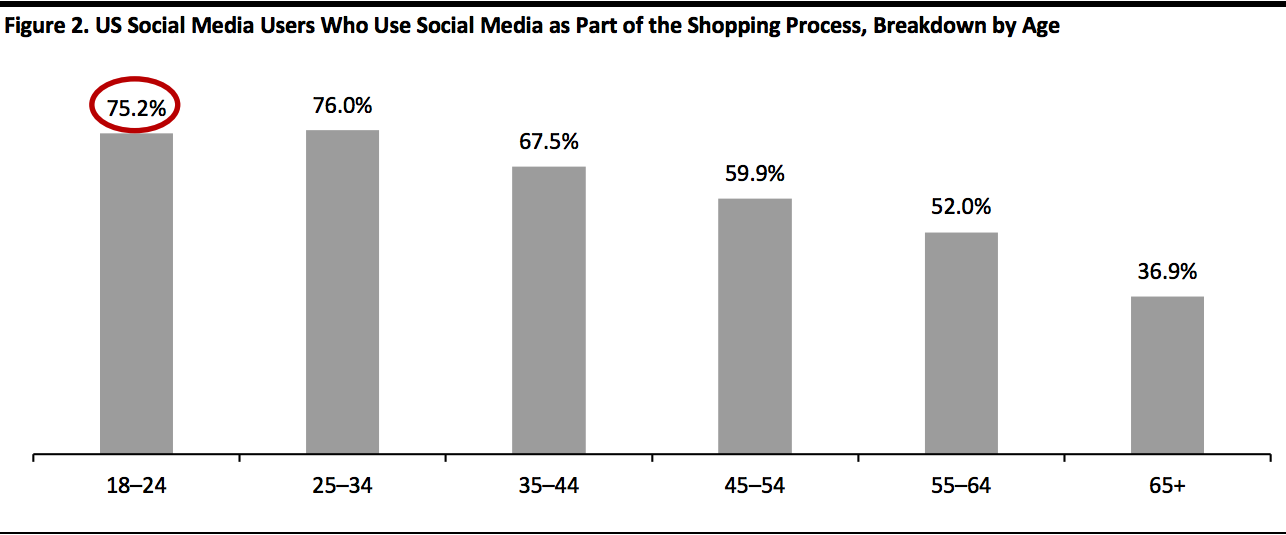 Using social media for shopping is defined as “discovering products, researching purchases or buying products on social media”
Using social media for shopping is defined as “discovering products, researching purchases or buying products on social media”Base: 1,393 US Internet respondents aged 18+, surveyed in November 2019
Source: Coresight Research[/caption] Among all US consumers using social media as part of the shopping process, Facebook is used by 72% for shopping, making it the most popular platform—and representing a significant lead over Instagram’s 33.0%. [caption id="attachment_105908" align="aligncenter" width="700"]
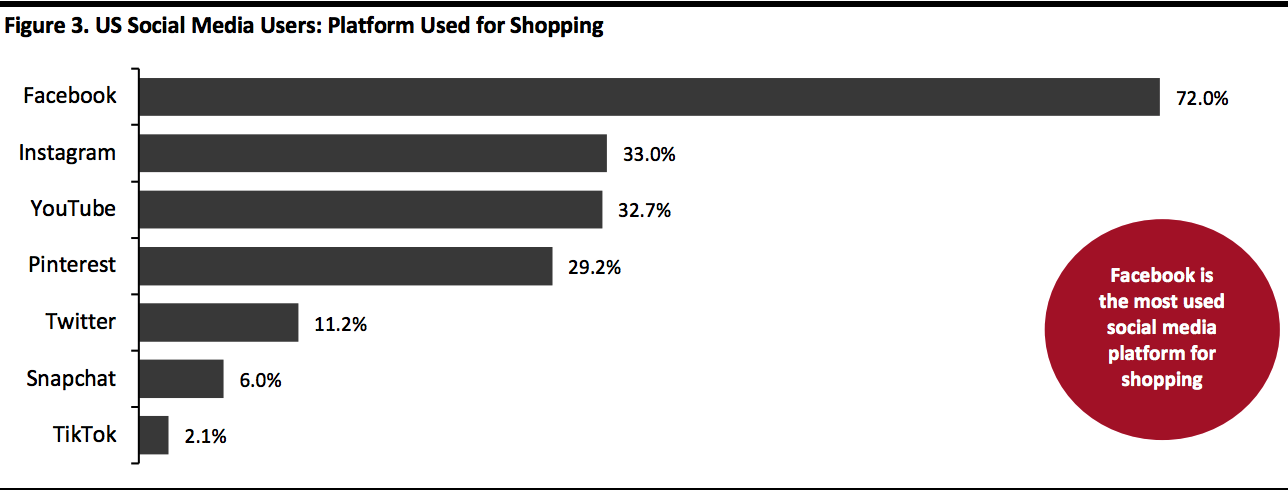 Using social media for shopping is defined as “discovering products, researching purchases or buying products on social media”
Using social media for shopping is defined as “discovering products, researching purchases or buying products on social media”Base: 854 US Internet respondents aged 18+ who use social media as part of the shopping process, surveyed in November 2019
Source: Coresight Research[/caption] Breaking down the data further, we can see that male and female respondents showed largely similar preferences for the social media platforms they use as part of the shopping process. Notably, Facebook is the most popular platform among both men and women. Male social media shoppers are more likely than women to shop on almost every social media platform, with the exceptions being Facebook and Pinterest (as shown in Figure 3). Most significantly, 37.3% of female social media shoppers said that they use Pinterest for shopping, which is more than twice the 17.4% of men who use that platform. Pinterest is the second most popular platform for social media shopping among women, followed by Instagram. YouTube has a notably stronger penetration among male social media shoppers, probably because the platform features a variety of video content and channels centered around interests that typically appeal to men, such as gaming. [caption id="attachment_105909" align="aligncenter" width="700"]
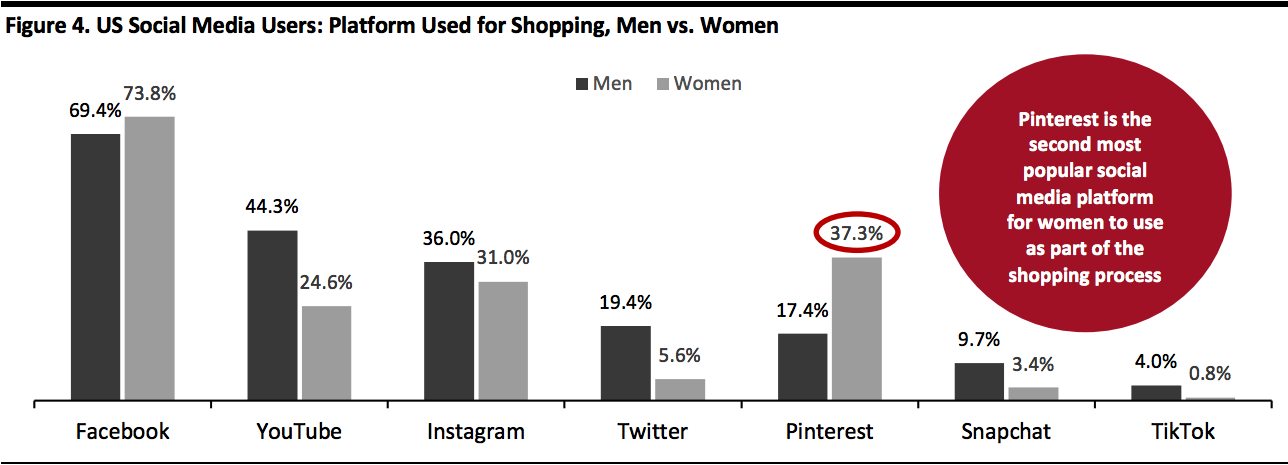 Using social media for shopping is defined as “discovering products, researching purchases or buying products on social media”
Using social media for shopping is defined as “discovering products, researching purchases or buying products on social media”Base: 854 US Internet respondents aged 18+ who use social media as part of the shopping process, surveyed in November 2019
Source: Coresight Research[/caption]
Researching and Buying on Social Media
For our survey, we identified shopping on social media as two discrete stages:- Discovering products or researching purchases on social media
- Purchasing via social media
- What categories they had used social media for, in terms of shopping.
- How often they used social media for these stages.
Frequency: Discovering versus Purchasing
In terms of discovering products or researching purchases, 57% of all respondents use social media as part of the shopping process, and virtually all (99.6%) of those shoppers discover or research products on social media. Furthermore, 38.2% of US social media shoppers utilize such platforms once a week or more. Social media is the new online mall! Perhaps predictably, a lower frequency of US social media shoppers use social media for purchasing, with 48% of all respondents stating that they buy through these platforms. This reflects not only that consumers browse products more than they buy them, but that shoppers often browse and discover across multiple channels, and this does not always reflect where they complete the purchase. Almost one-third of respondents who use social media as part of the shopping process make purchases more than once a month. However, among the options provided, the peak frequency of buying through social media for this consumer group is “less than once a month,” and around 14% never make purchases. [caption id="attachment_105910" align="aligncenter" width="700"]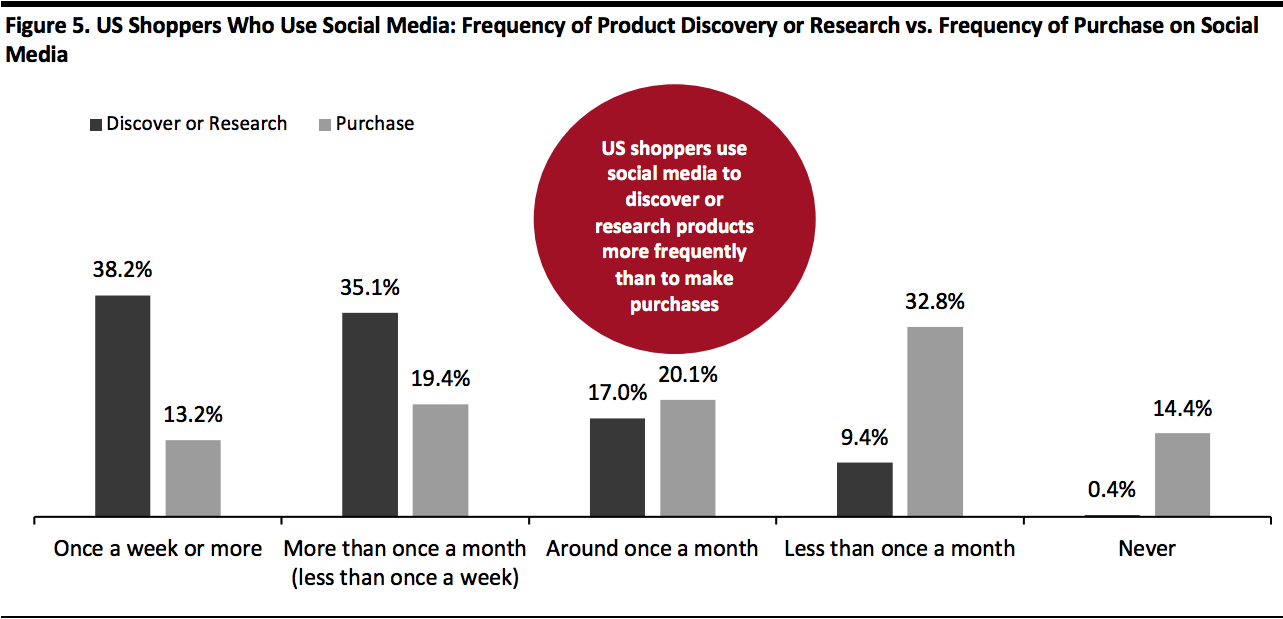 Base: 854 US Internet respondents aged 18+ who use social media as part of the shopping process, surveyed in November 2019
Base: 854 US Internet respondents aged 18+ who use social media as part of the shopping process, surveyed in November 2019Source: Coresight Research[/caption] Male respondents who use social media as part of the shopping process purchase more often than women, with 21.4% of men buying products through social media once a week or more, which is nearly three times the 7.5% of women. One reason for this could be that buying and selling secondhand merchandise is a huge market on social media, and used electronics and video games are often sold rather than disposed of—products that typically resonate with male shoppers. [caption id="attachment_105911" align="aligncenter" width="520"]
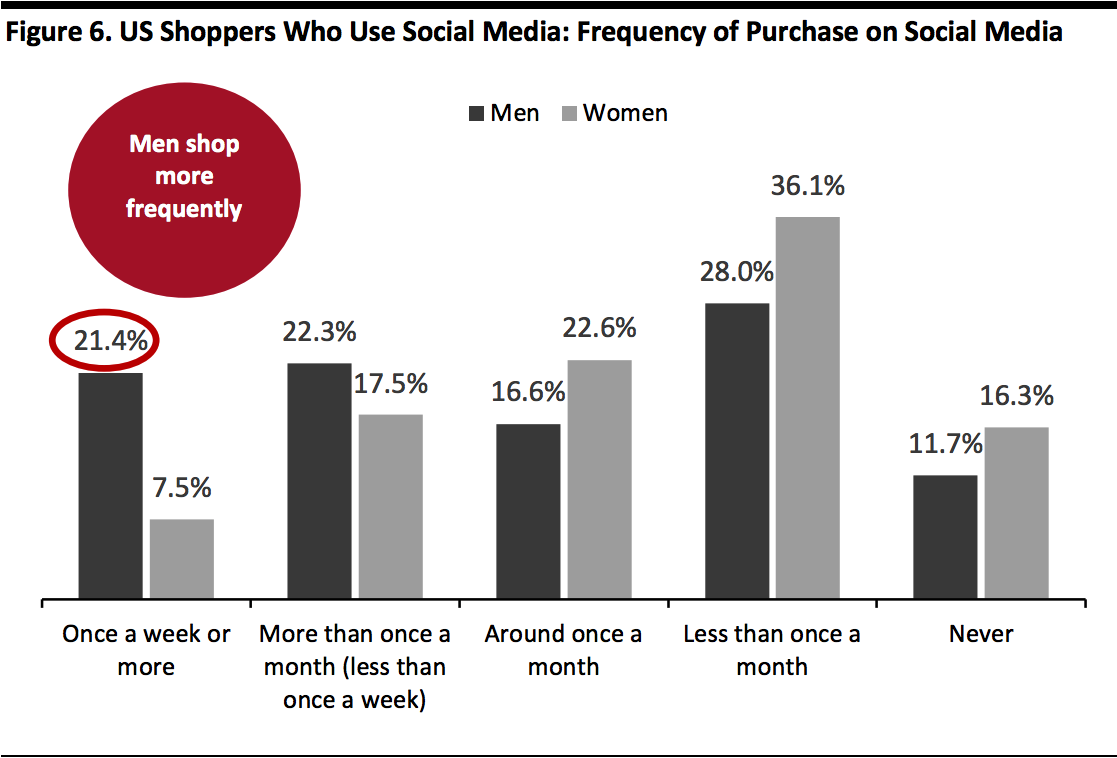 Base: 854 US Internet respondents aged 18+ who use social media as part of the shopping process, surveyed in November 2019
Base: 854 US Internet respondents aged 18+ who use social media as part of the shopping process, surveyed in November 2019Source: Coresight Research[/caption]
Categories: Discovering versus Purchasing
In terms of discovering products or researching purchases, apparel and beauty products are the top categories for US social media shoppers. This is reflective of social media being popular among young consumers for shoppers (shown in Figure 1), who tend to be more avid purchasers of these categories in general. In terms of purchasing, we see fashion again being the most popular category, with almost two-thirds of those who buy products on social media stating that they purchase clothing, footwear and accessories. [caption id="attachment_105912" align="aligncenter" width="700"] Base: 851 US Internet respondents age 18+ who use social media to discover products or research purchases, and 731 US Internet users aged 18+ who use social media to purchase products, surveyed in November 2019
Base: 851 US Internet respondents age 18+ who use social media to discover products or research purchases, and 731 US Internet users aged 18+ who use social media to purchase products, surveyed in November 2019Source: Coresight Research[/caption] From our data on discovery versus purchase, we can analyze the “buying-to-discovery” ratio by category—the proportion of those who make purchases on social media represented as a percentage of respondents who say they use social media to discover or research products. The apparel and beauty segments lead in terms of discovery translating to purchasing on social media. This perhaps suggests that there is a bias of content and/or that KOLs are driving sales on social media. The high numbers could also be a product of the highly image-driven nature of apparel and beauty purchases, with inspirational visuals likely to prompt purchasing more than in other categories. The survey data suggests that social media is successful in prompting impulse-driven purchases in those frequently purchased, discretionary categories where aesthetics are key. For categories such as electronics or food, where other factors such as product specifications or ingredients, respectively, come into play, we see much lower buying-to-discovery ratios. [caption id="attachment_105913" align="aligncenter" width="700"]
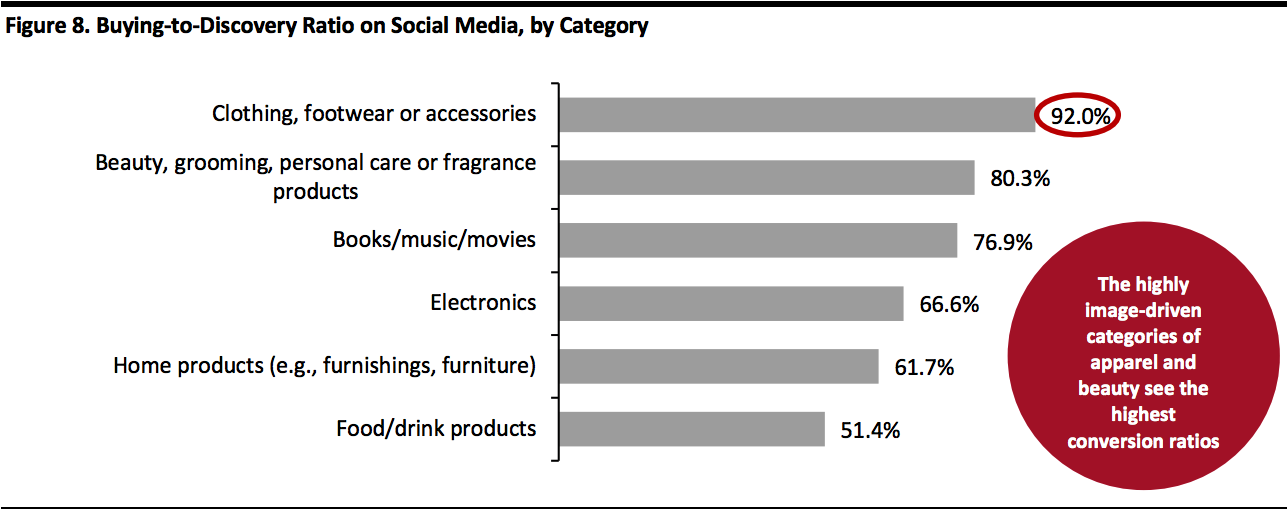 The ratio shows the proportion of those who use social media to make purchases as a percentage of those who used social media for product discovery or research
The ratio shows the proportion of those who use social media to make purchases as a percentage of those who used social media for product discovery or researchSource: Coresight Research[/caption] Apparel purchasing was highest among the youngest adult age group: Just over 70% of social media shoppers aged 18–24 purchased clothing, footwear and accessories on social media—the highest across all age groups. Some 47.9% of shoppers aged 25–34 who make purchases on social media buy beauty and personal care products, a slightly higher proportion than their younger peers at 46.9%. [caption id="attachment_105914" align="aligncenter" width="700"]
 Not all age groups shown due to small sub-samples for some age groups
Not all age groups shown due to small sub-samples for some age groupsBase: 731 US Internet respondents aged 18+ who use social media to purchase products, surveyed in November 2019
Source: Coresight Research[/caption] Male social media shoppers are more likely to purchase food, drinks, electronics and hobby items on social media than women. However, less than one-third of men that make purchases through social media buy beauty and personal care products—a category that has strong traction with female social media shoppers. [caption id="attachment_105915" align="aligncenter" width="700"]
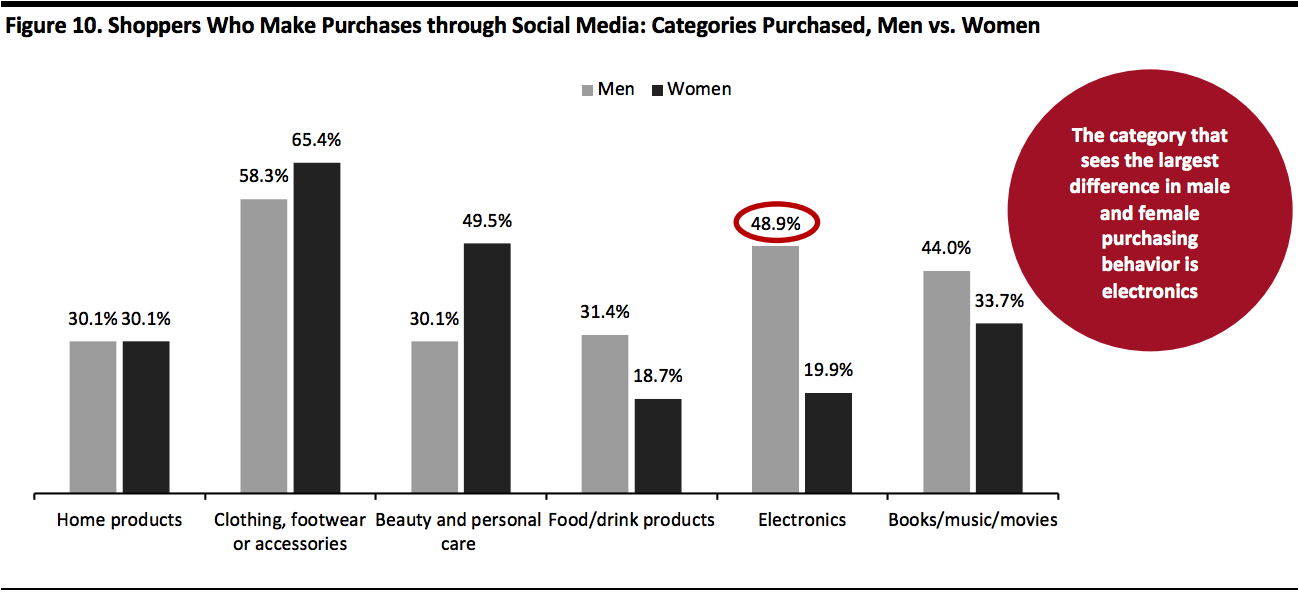 Base: 731 US Internet respondents aged 18+ who use social media to purchase products, surveyed in November 2019
Base: 731 US Internet respondents aged 18+ who use social media to purchase products, surveyed in November 2019Source: Coresight Research[/caption]
Abandoning Purchases
Among respondents who use social media to discover products or research purchases as part of the shopping process, 17.5% will “often/always” give up the purchase due to a platform’s lack of built-in functionality. For brands and retailers, it is crucial to provide a one-step discover-to-purchase solution that will remove friction in the consumer journey and drive improved conversion rates. [caption id="attachment_105916" align="aligncenter" width="520"]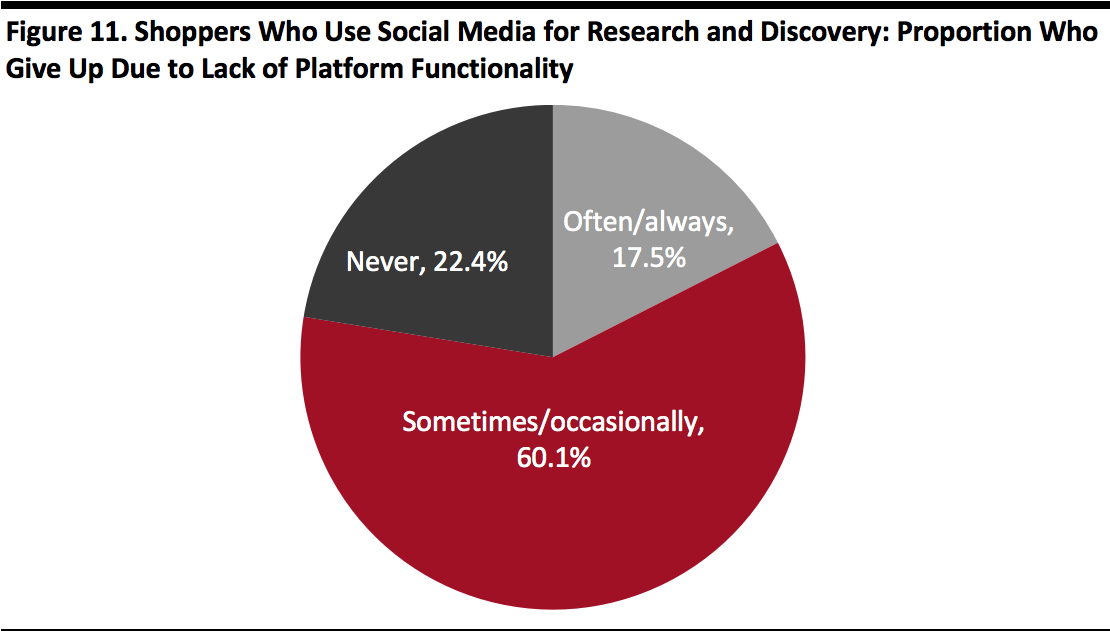 Base: 851 US Internet respondents aged 18+ who use social media to discover products or research purchases as part of the shopping process, surveyed in November 2019
Base: 851 US Internet respondents aged 18+ who use social media to discover products or research purchases as part of the shopping process, surveyed in November 2019Source: Coresight Research[/caption] By age group, social media shoppers aged 25–34 have the highest proportion of “often/always” giving up. Less than 10% of this age category will continue to make a purchase through social media if there is no built-in functionality, possibly due to the busy schedule of this age group, which is typically made up of working professionals. On the other hand, 17.8% of the 35-44 year olds will not give up and instead will make purchases elsewhere. [caption id="attachment_105917" align="aligncenter" width="700"]
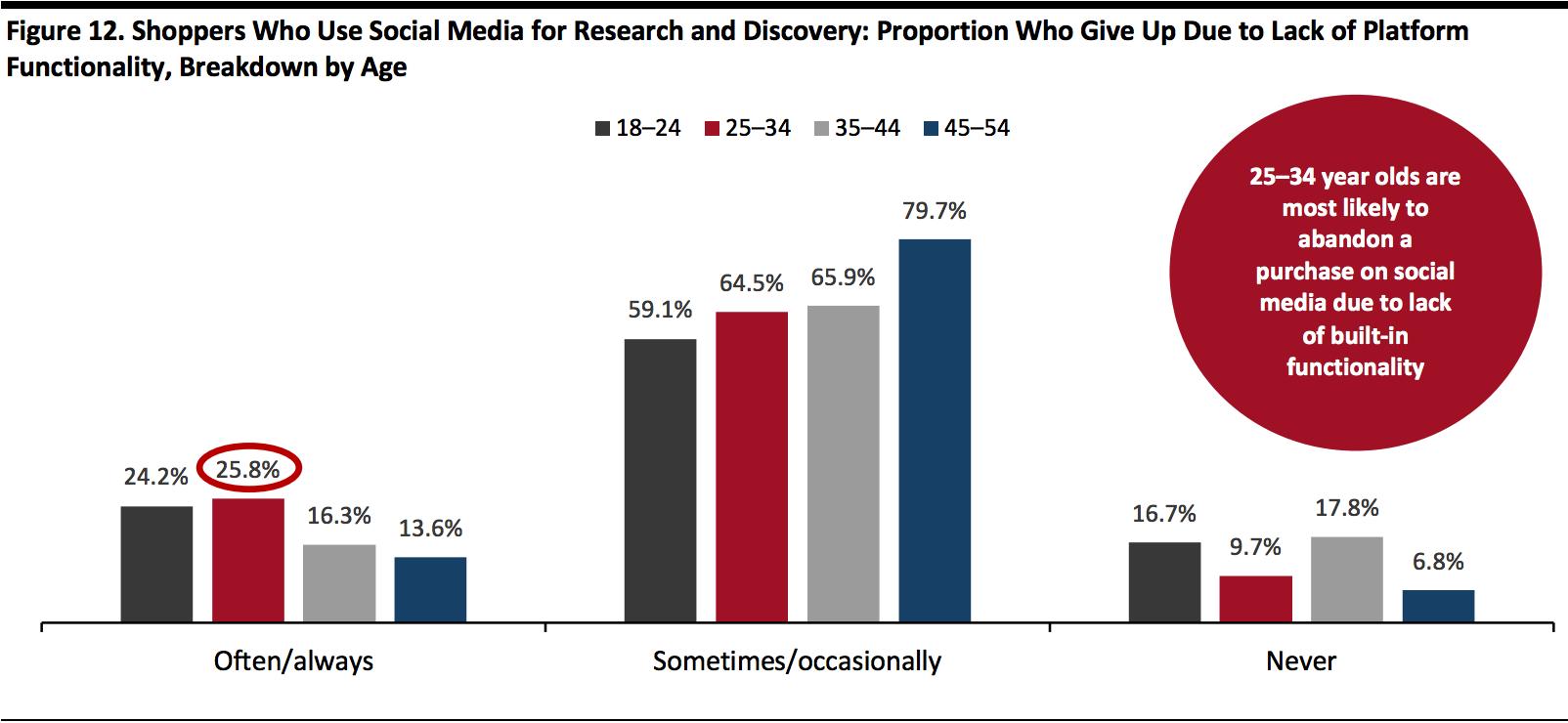 Base: 851 US Internet respondents aged 18+ who use social media to discover products or research purchases as part of the shopping process, surveyed in November 2019
Base: 851 US Internet respondents aged 18+ who use social media to discover products or research purchases as part of the shopping process, surveyed in November 2019Source: Coresight Research[/caption]
Monthly Spending Behaviors
We asked our survey respondents how much they spend on discretionary purchases, and the results showed that those using social media as part of the shopping process tend to spend more on non-essential purchases. Overall, 42.1% of respondents said that they spend up to $50 a month on discretionary shopping, and another 28.1% spend between $51 and $100. Of particular interest to retailers and brands are the 9.7% that spend more than $300 a month. Importantly, consumers who use social media as part of the shopping process are more likely to spend more than those who do not. Of respondents who do not use social media as part of the shopping process, 56.8% spend less than $50 on non-essential retail purchases per month, and only 6.7% spend more than $300 on the same category monthly. [caption id="attachment_105918" align="aligncenter" width="700"]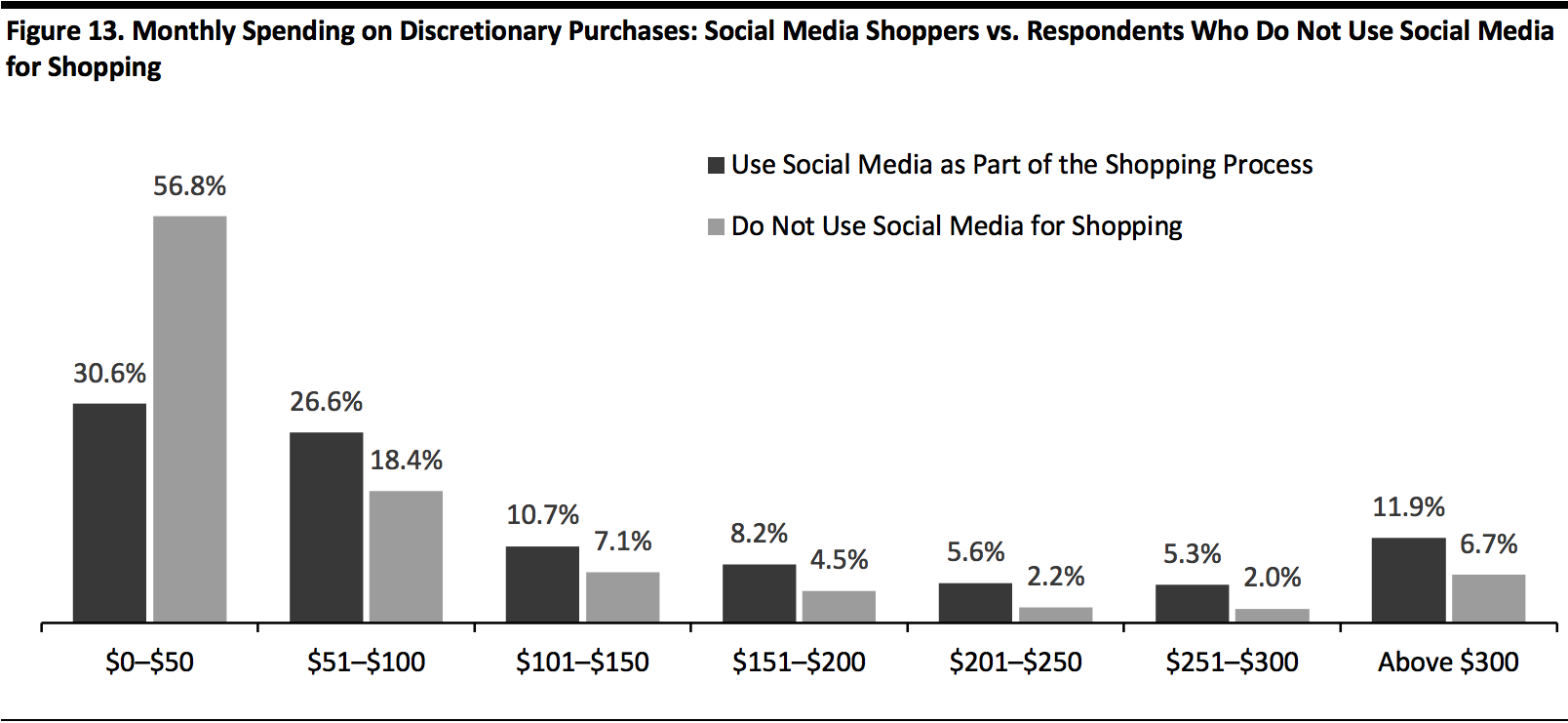 Base: 1,509 US Internet respondents aged 18+ and 854 of those who use social media as part of shopping process, surveyed in November 2019.
Base: 1,509 US Internet respondents aged 18+ and 854 of those who use social media as part of shopping process, surveyed in November 2019.Source: Coresight Research[/caption]
The Impact of Influencers
Social media influencers and/or celebrities can have a significant impact on the purchasing decisions of their followers. Our survey revealed that 51.6% of respondents who use social media as part of the shopping process follow influencers or celebrities on social media. The proportion decreases as age increases. Respondents aged 18–24 have the highest rate across all age groups, with 80.5% stating that they follow influencers or celebrities on social media. It is worth noting the trend shown in Figure 16, whereby the older social media shoppers are, the less likely they are to follow influencers. [caption id="attachment_105919" align="aligncenter" width="700"] Not all age groups shown due to small sub-samples for some age groups
Not all age groups shown due to small sub-samples for some age groupsBase: 854 US Internet respondents aged 18+ who use social media as part of the shopping process, surveyed in November 2019
Source: Coresight Research[/caption] Of the US social media shoppers who follow influencers, 19.7% stated that their shopping decisions are “often/always” affected by influencers or celebrities on social media. However, despite being less likely to follow influencers on social media than their younger peers, consumers aged 25–34 are most affected by influencers and celebrities, with 25.8% of that age group saying that their shopping behaviors are “often/always” impacted by KOLs. [caption id="attachment_105920" align="aligncenter" width="700"]
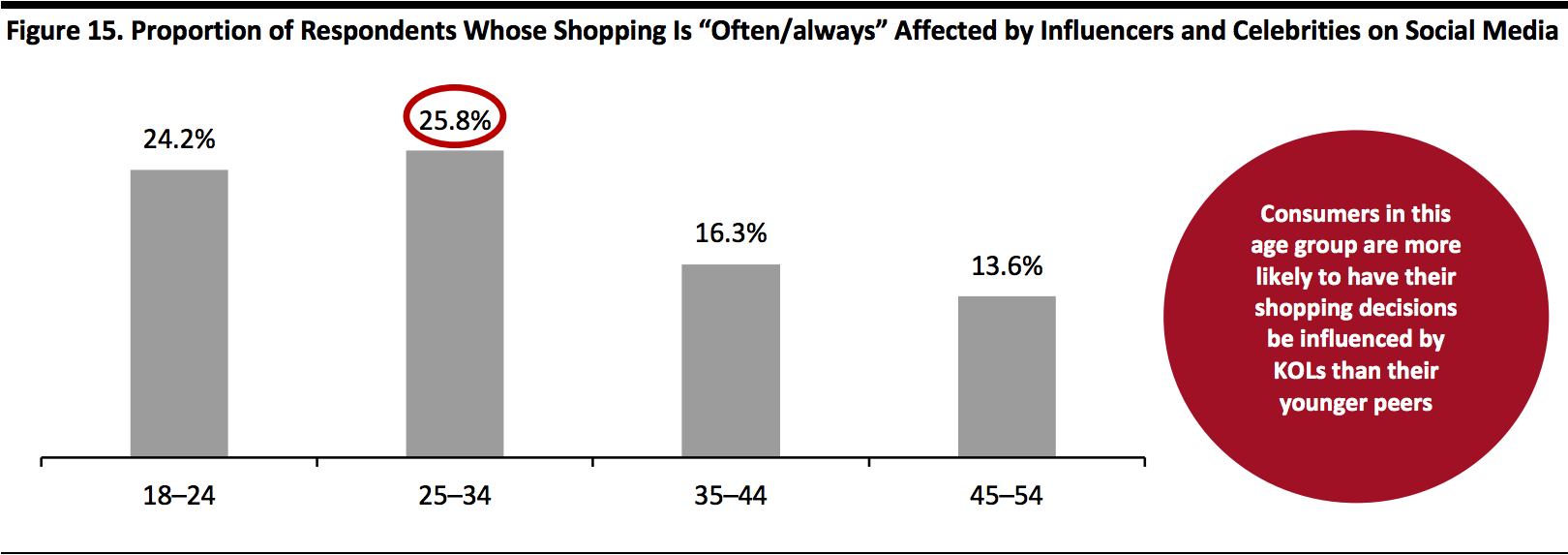 Not all age groups shown due to small sub-samples for some age groups
Not all age groups shown due to small sub-samples for some age groupsBase: 441 US Internet respondents aged 18+ who use social media as part of the shopping process and follow influencers/celebrities on social media and 282 social media shoppers, surveyed in November 2019
Source: Coresight Research[/caption] There is a disparity between the impact of influencers on male and female social media shoppers. Men seem to be more engaged with influencers, as a much higher proportion of them (28.6%) stated that their shopping is “often/always” affected by influencers or celebrities—more than double the 12.7% of female respondents. The rising casualization trend in workplace attire is resulting in new apparel categories, often called “workleisure” or “performance professional”. Driven by this casualization, men are venturing beyond suits and looking to social media influencers for fashion advice. Men are also more likely to engage with their peers on social media for gaming and fitness advice. In addition, 34.3% of male social media users said that they are interested in being an influencer on social media, versus 19.3% of women. However, only 0.9% of men stated that they are influencers, compared to 1.4% of women.
Post-Purchase Activities
Sharing content is an important feature of social commerce. Overall, 12.9% of respondents who use social media as part of the shopping process “often/always” post about their experiences. Survey results suggest that respondents of all ages post information about their shopping journey, such as photos and videos of their purchases. We see a sharp tail-off in the number of consumers sharing purchases over the 45–54 age group. [caption id="attachment_105921" align="aligncenter" width="700"] Base: 854 US Internet respondents aged 18+ who use social media as part of the shopping process, surveyed in November 2019.
Base: 854 US Internet respondents aged 18+ who use social media as part of the shopping process, surveyed in November 2019.Source: Coresight Research[/caption]